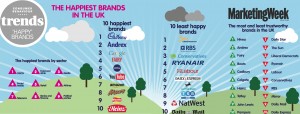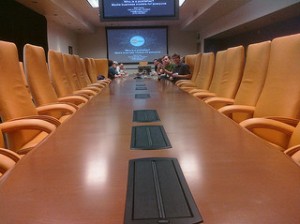
A new study by Isobel and Cog Research, Happy Brands, reveals that the happiest brands build emotional connections with consumers. The study defined happy brands as having four core characteristics: playfulness, happiness, trustworthiness, generosity, and optimism. A total of 1,250 U.K. consumers ranked one hundred of the largest brands from the biggest market categories on those five characteristics as part of this study, and you can see the winners and losers in the infographic to the left.
The happiest brands according to this study are Cadbury, Andrex, and Google while the least happy brands (excluding political parties) are The Royal Bank of Scotland, Ryanair, and The Daily Express. The most trustworthy brands are Nivea, Andrex, and Fairy, but the least trustworthy brands (excluding political parties) are Daily Star, The Sun, and Ryanair.
Isobel found that there is a clear connection between emotions of happiness, perceptions of trust, honesty, and generosity, and brand affinity which grows proportionally with consistency of brand messages and brand experiences. In other words, an ad campaign that tries to position a brand as happy, trustworthy, and honest won’t get the desired results if the ad is inconsistent with the audience’s existing experiences with and perceptions of the brand.
The results of this study aren’t surprising. In 2008, I wrote here on the Corporate Eye blog, “Perhaps the single most important aspect of developing customer loyalty is emotional involvement in your brand. Customers who feel an emotional connection and response to your brand are inherently loyal to it.” I also shared the three steps to build emotional involvement in your brand: stability, sustainability, and security. These are not new concepts. However, what is surprising is that brand marketers still have to fight to get executive buy-in on the importance of investing time, resources, and budget dollars to building emotional connections between brands and consumers.
It’s not just conceptual, visionary marketers calling for the strategic prioritization of emotional branding. Analytical, data-driven marketers understand its value, too. In 2011, I shared results of a study that showed emotional brand advertising is more impactful than logical brand advertising.
In 2012, I wrote an article about the critical importance of consumer emotional involvement in brands. I wrote, “Who says emotions don’t matter? Not brand managers. When consumers are emotionally involved in a brand, that brand has reached an important point of success. Emotional involvement in a brand leads to brand loyalty, brand advocacy, and brand guardianship that money can’t buy. Word-of-mouth marketing by consumers who are emotionally connected to a brand is extremely powerful. Don’t believe me? Ask the marketing team at Harley Davidson or Apple. They’ll tell you how important emotional involvement in a brand is.”
Brands that rank as the happiest understand the importance of consumer emotional involvement in brands. Google uses storytelling to build emotional connections between consumers and its tech brand—a type of brand that is not typically viewed as being inherently emotional. Google started its push to build emotional connections in 2011 with the launch of the first Google Chrome offline ad campaign. AT&T was a brand to benchmark for building emotional connections with consumers when its “Reach out and Touch Someone” ad campaign was a television staple. Today, AT&T is trying to regain that emotional connection through a new “It’s Complicated” ad campaign. Red Bull builds emotional connections with consumers in all of its marketing initiatives and brand experiences. Remember the Red Bull Stratos event? That was a perfect (and successful) example of emotional branding.
Consumers are innately emotional human beings. Trying to work against those emotions is useless, yet marketers still have to fight for the resources and money they need to build emotional connections between their brands and their target audiences. I started writing for Corporate Eye about branding and the importance of building emotional connections between brands and consumers in 2008. That’s seven years ago. I wonder if we’ll still be having this conversation seven years from now in 2020. What do you think?
Lucy is Editor at Corporate Eye


